Evergreen plants have been considered to be potent symbols of growth and re-birth particularly in Europe and Western Asia for thousands of years, they are especially welcome in the barren winter months in time for Christmas.
Christmas Celebration Plant Lore
The Holly and the Ivy, Mistletoe, Christmas Trees, Yule Log
Evergreen plants were originally used in winter festivities as a means of ensuring that life and growth would return again in the spring, these days they provide a bright and welcome reminder of the warmer, greener and more fruitful days to come in the middle of the bleak midwinter.
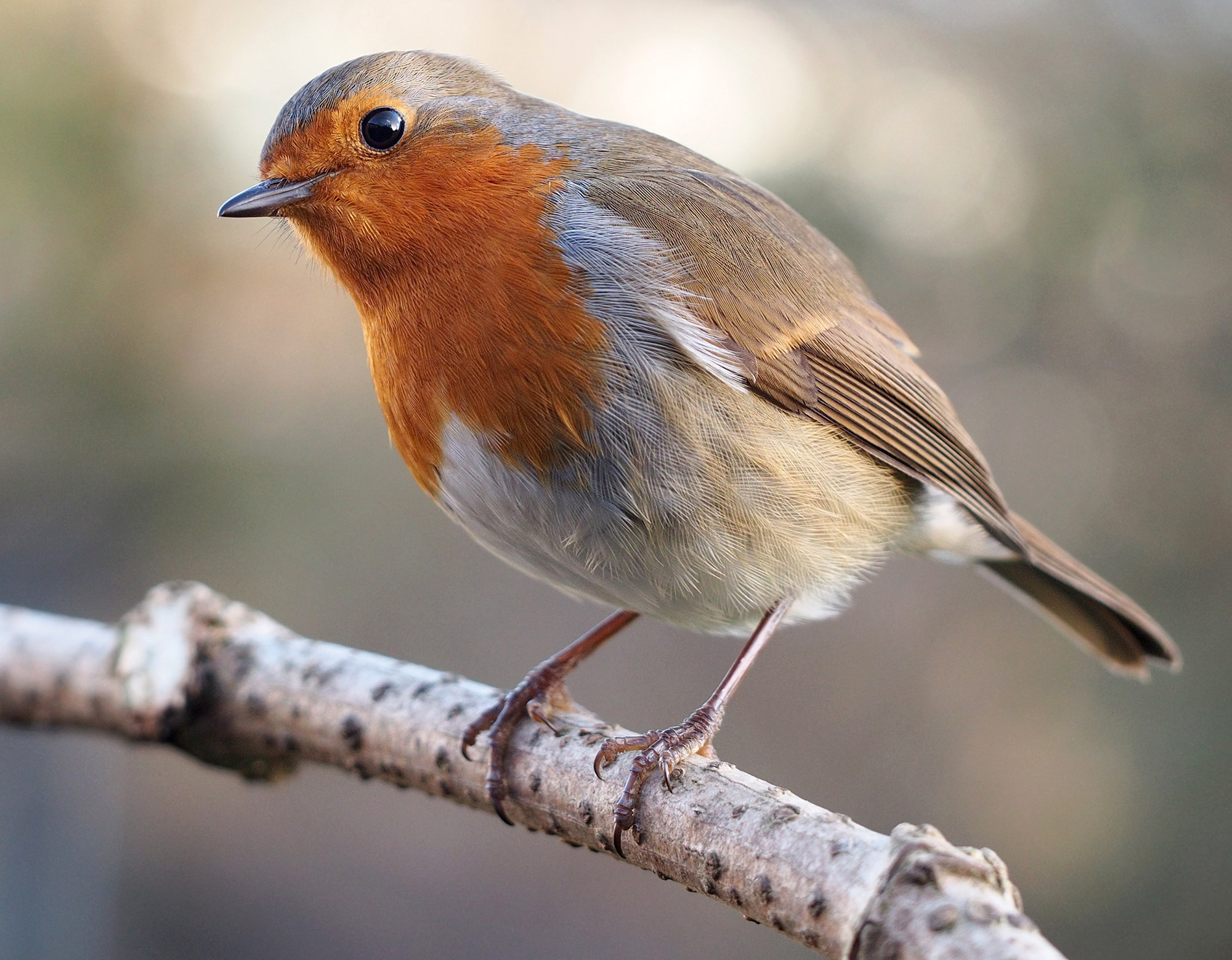
The plants that we now bring into our homes to celebrate Christmas time are almost without exception, taken from pagan midwinter feasts of Northern Europe rather than from Christian origins and pre-date modern religious significance which has been overlaid onto the older traditions. One of the main differences is that we now bring such greenery into our homes much sooner than used to be done. It shouldn't be brought into the house until Christmas Eve as this was considered bad luck. Although these days Christmas is just far too exciting an event for most people who celebrate it to wait - particularly if you have children!
Holly, Ilex
The holly and the ivy,
Now
both are full well grown.
Of all the trees that are in the
wood,
The holly bears the crown
Traditional
Christmas Carol (1st verse)
![]() Like other evergreens, holly has represented immortality ever
since people began to look to plants for inspiration, it has
been regarded as a plant of good omen since Early Times
(It is now widely accepted by scholars that "Early Times" lies
between the Late Eocene and "Donkeys Years Ago").
Like other evergreens, holly has represented immortality ever
since people began to look to plants for inspiration, it has
been regarded as a plant of good omen since Early Times
(It is now widely accepted by scholars that "Early Times" lies
between the Late Eocene and "Donkeys Years Ago").
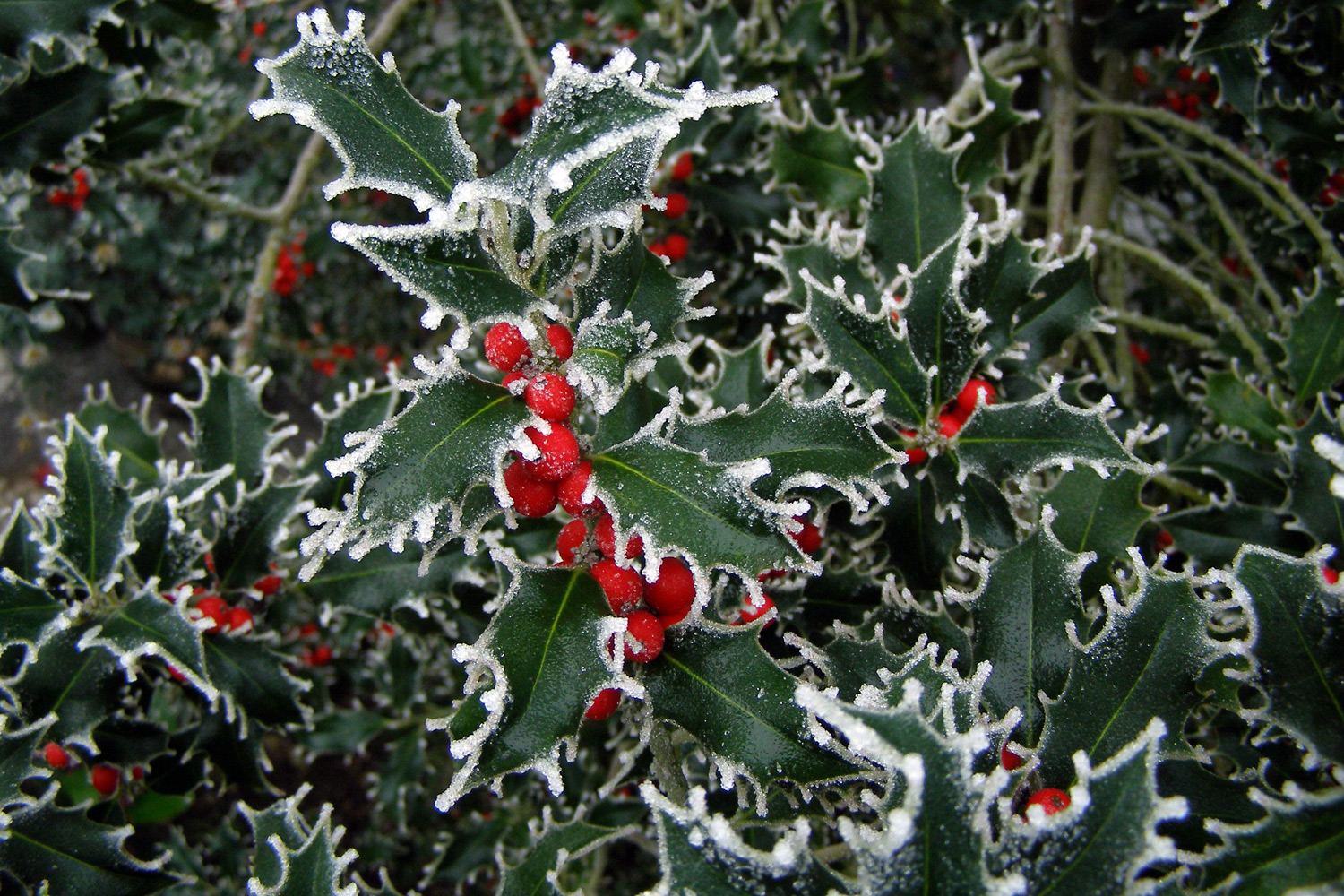
![]() Holly has the advantageous property of looking as good in mid-winter
as in mid-summer, other evergreens can look a bit poorly
in the winter even though they perk up again when spring arrives
- this amongst other things probably has helped its position
in folk-lore.
Holly has the advantageous property of looking as good in mid-winter
as in mid-summer, other evergreens can look a bit poorly
in the winter even though they perk up again when spring arrives
- this amongst other things probably has helped its position
in folk-lore.
All evergreens shed their leaves through the year, they just don't do it all in one go like deciduous plants. Holly tends to do this mainly in the spring, again helping it look good through the winter.
![]() Holly was taken into homes when winter began to shelter the
elves and fairies who could live with mortals at this
time without causing injury (maybe they get trodden on at other
times?). Holly was regarded as an excellent form of protection
for all manner of things but specifically against evil spirits,
poisons, thunder and lightning and the evil eye.
Holly was taken into homes when winter began to shelter the
elves and fairies who could live with mortals at this
time without causing injury (maybe they get trodden on at other
times?). Holly was regarded as an excellent form of protection
for all manner of things but specifically against evil spirits,
poisons, thunder and lightning and the evil eye.
![]() There are records of gifts of holly being given at the Roman
festival of Saturnalia which lasted 5 days and ended with the
winter solstice. Early Christians began to use holly in Nativity
celebrations to disguise their Christianity, as it was sacred
to pagan gods it gave the impression that they were taking part
in Saturnalia.
There are records of gifts of holly being given at the Roman
festival of Saturnalia which lasted 5 days and ended with the
winter solstice. Early Christians began to use holly in Nativity
celebrations to disguise their Christianity, as it was sacred
to pagan gods it gave the impression that they were taking part
in Saturnalia.
![]() Holly along with mistletoe was banned by the early Christian
church due to its connections with pagans. This ban
wasn't lifted until the 1600's, by then legends had been made
up about holly and the crucifixion (clearly not by botanists)
to fit something that was a jolly useful winter decoration.
One such erstwhile tale claims that holly sprang up under Christ's
feet as he walked to Calgary, the red berries representing his
blood. Another is that the crown of thorns was made of
holly and the berries which were originally white were stained
red with blood when the spikes broke the Christ's skin. There
are even claims that holly wood was used to make the cross.
Holly along with mistletoe was banned by the early Christian
church due to its connections with pagans. This ban
wasn't lifted until the 1600's, by then legends had been made
up about holly and the crucifixion (clearly not by botanists)
to fit something that was a jolly useful winter decoration.
One such erstwhile tale claims that holly sprang up under Christ's
feet as he walked to Calgary, the red berries representing his
blood. Another is that the crown of thorns was made of
holly and the berries which were originally white were stained
red with blood when the spikes broke the Christ's skin. There
are even claims that holly wood was used to make the cross.
![]() More recently the "Holly King" a tradition carried on in mummers
plays would vie with the "Oak King" for the hand of
a fair maiden. At midsummer the oak king was defeated by the
holly king, at midwinter, the oak king was victorious and so
the seasonal tides flowed smoothly.
More recently the "Holly King" a tradition carried on in mummers
plays would vie with the "Oak King" for the hand of
a fair maiden. At midsummer the oak king was defeated by the
holly king, at midwinter, the oak king was victorious and so
the seasonal tides flowed smoothly.
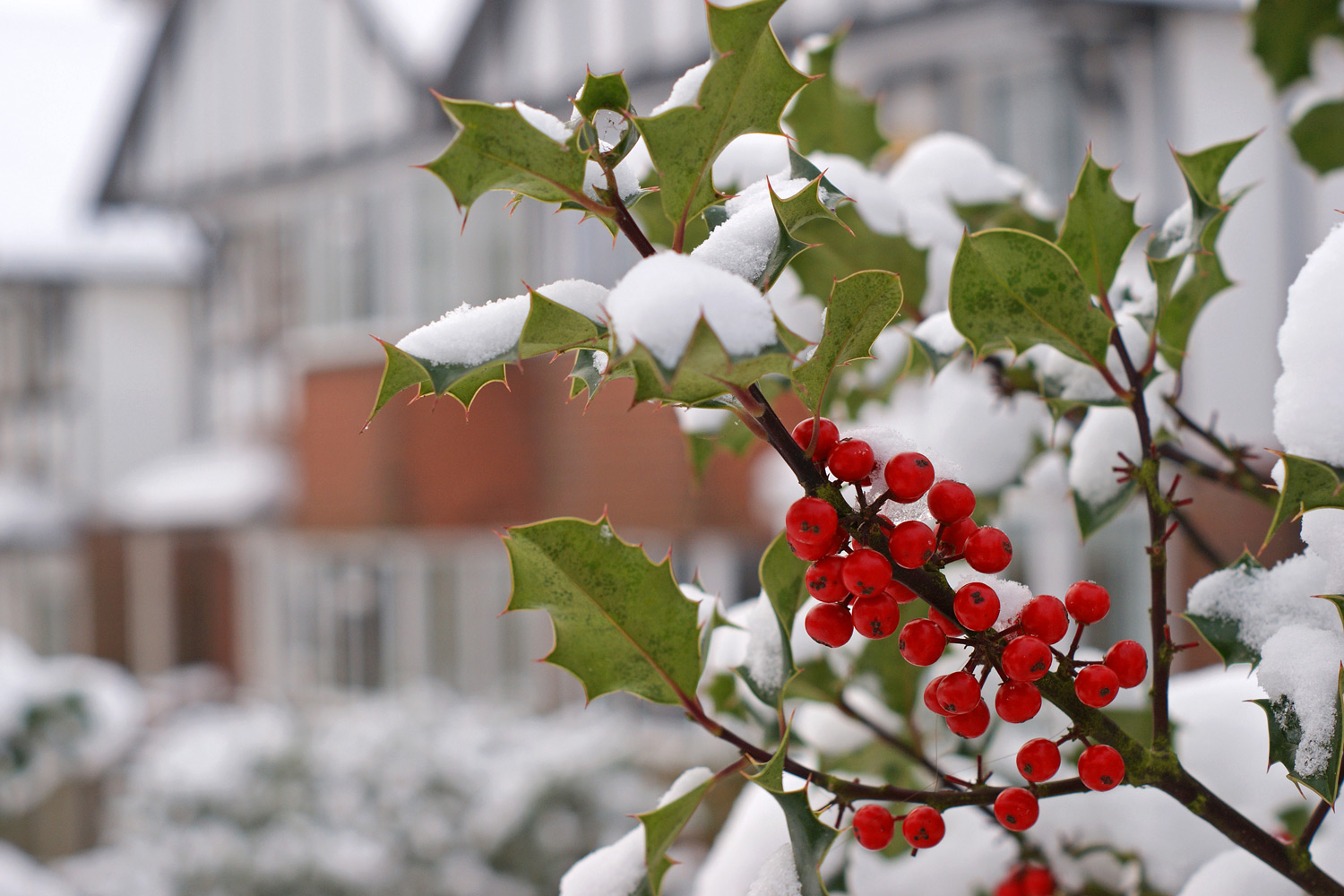
![]() In some parts of Ireland, the holly from Christmas was kept
and burned to help cook the pancakes on Shrove Tuesday.
In some parts of Ireland, the holly from Christmas was kept
and burned to help cook the pancakes on Shrove Tuesday.
![]() In rural areas of England, a bunch of holly was placed in the
stable or cow shed on Christmas Eve to bring luck and favour
the animals.
In rural areas of England, a bunch of holly was placed in the
stable or cow shed on Christmas Eve to bring luck and favour
the animals.
![]() A European tradition says that whoever brought the first holly
into the house, husband or wife, at Christmas would rule the
house for the next year. Likewise prickly holly is
said to be male while smooth leafed holly is said to be female,
and which sort is brought in will affect whether the man or
woman of the house will hold sway.
A European tradition says that whoever brought the first holly
into the house, husband or wife, at Christmas would rule the
house for the next year. Likewise prickly holly is
said to be male while smooth leafed holly is said to be female,
and which sort is brought in will affect whether the man or
woman of the house will hold sway.
![]() Bringing holly into the house before Christmas Eve will lead
to family quarrels, though as the tree symbolizes peace
and joy, disputes and differences of opinion can be settled
under a holly tree.
Bringing holly into the house before Christmas Eve will lead
to family quarrels, though as the tree symbolizes peace
and joy, disputes and differences of opinion can be settled
under a holly tree.
![]() Holly is also claimed to have many healing powers when used
as a herb. It has been used for asthma, rheumatism,
gout and dropsy. It was administered as holly tea in parts of
central Europe, India and by Native Americans who would use
it as a cure for measles.
Holly is also claimed to have many healing powers when used
as a herb. It has been used for asthma, rheumatism,
gout and dropsy. It was administered as holly tea in parts of
central Europe, India and by Native Americans who would use
it as a cure for measles.
![]() Holly berries can be eaten by wildlife such as birds, but are
poisonous to humans causing vomiting.
Holly berries can be eaten by wildlife such as birds, but are
poisonous to humans causing vomiting.
![]() Things to avoid with holly which bring bad luck:
Things to avoid with holly which bring bad luck:
- burn it while still green
- smash the berries
- bring holly flowers into the house in the summer
![]() A sprig of holly on the bedpost however is thought to bring
happy dreams and holly decorations throughout the house bring
a pleasant and jubilant atmosphere.
A sprig of holly on the bedpost however is thought to bring
happy dreams and holly decorations throughout the house bring
a pleasant and jubilant atmosphere.
Holly varieties and cultivation
Heigh-ho! sing, heigh-ho! unto
the green holly
Most friendship is feigning, most loving
mere folly.
Then heigh-ho! the holly!
This life is most
jolly.
Shakespeare - As You Like It
 Begonia Merry Christmas Begonia Merry Christmas£ 15.99 |  Clematis Christmas Surprise Clematis Christmas Surprise£ 17.99 |  Helleborus niger - Christmas Rose Helleborus niger - Christmas Rose£ 19.99 |
 Helleborus niger Christmas Carol Helleborus niger Christmas Carol£ 19.99 |
Ivy - Hedera
![]() Ivy is associated with Bacchus the Roman god (he of "Bacchanalian
pleasures" - drinking mainly) and is therefore thought to bring
good luck, fun and ecstatic happiness! Growing the
plant on the outside walls of a house is believed to be a strong
deterrent against misfortune, but if a house plant dies then
financial strains may be approaching.
Ivy is associated with Bacchus the Roman god (he of "Bacchanalian
pleasures" - drinking mainly) and is therefore thought to bring
good luck, fun and ecstatic happiness! Growing the
plant on the outside walls of a house is believed to be a strong
deterrent against misfortune, but if a house plant dies then
financial strains may be approaching.
![]() Ivy is generally considered
to be bad luck if brought into the house or if given as a gift
at any time of the year other than Christmas. Even
then it must be brought in or given along with holly which is
powerful enough to counter any negative influence that the ivy
may have.
Ivy is generally considered
to be bad luck if brought into the house or if given as a gift
at any time of the year other than Christmas. Even
then it must be brought in or given along with holly which is
powerful enough to counter any negative influence that the ivy
may have.
![]() If a man places one of ten leaves gathered on the 31st
of October (Halloween) under his pillow it is thought he will
dream of his future bride.
Women are advised to recite the following once they have collected
the leaves "Ivy, ivy, I love you, In my bosom I put you, The
first young man who speaks to me, My future husband he shall
be".
If a man places one of ten leaves gathered on the 31st
of October (Halloween) under his pillow it is thought he will
dream of his future bride.
Women are advised to recite the following once they have collected
the leaves "Ivy, ivy, I love you, In my bosom I put you, The
first young man who speaks to me, My future husband he shall
be".
![]() In Shropshire it was believed that drinking from an ivy cup
would cure a child of whooping cough, or an alcoholic of his
alcoholism.
In Shropshire it was believed that drinking from an ivy cup
would cure a child of whooping cough, or an alcoholic of his
alcoholism.
Oh roses for the flush of youth,
And laurel for the perfect prime;
But pluck an ivy branch
for me
Grown old before my time.
Christina Rossetti
Mistletoe - Viscum album, the
commonest European form,
![]() Mistletoe
is believed by pagans to give protection, and be useful in love,
to be a bestower of life and fertility, a protector against
poison, and an aphrodisiac.
Mistletoe
is believed by pagans to give protection, and be useful in love,
to be a bestower of life and fertility, a protector against
poison, and an aphrodisiac.

![]() It can be worn as a protective amulet (well as an amulet).
It was thought to be a good anti-lightning charm.
To divert lightning a branch should be placed above the doorway
to your house to protect it during thunderstorms. It supposedly
extinguishes fires (can't find any details how though). The
branch also prevents the entrance of witches if hung above a
doorway - but what if you meet one in the doorway? Is a kiss
in order?
It can be worn as a protective amulet (well as an amulet).
It was thought to be a good anti-lightning charm.
To divert lightning a branch should be placed above the doorway
to your house to protect it during thunderstorms. It supposedly
extinguishes fires (can't find any details how though). The
branch also prevents the entrance of witches if hung above a
doorway - but what if you meet one in the doorway? Is a kiss
in order?
For the most effective magic (get this) it's supposed to be harvested using a golden sickle during a full moon- seems like a good excuse to me - "It would have worked but I only had my ordinary sickle on me and it was the wrong night ....."
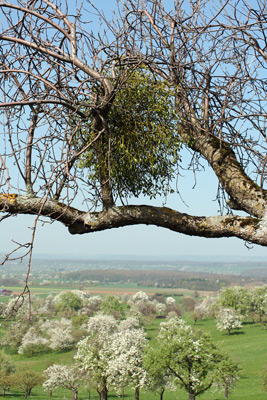
![]() Botanically mistletoe is a partial parasite (a semiparasite).
Seeds spread by birds (often in their droppings - which act
as glue and fertiliser) germinate and grow on the branches or
trunk of a tree. The plant sends out roots that penetrate into
the tree. It certainly takes up water and mineral nutrients
from the tree as it has no other source, but it makes its own
food by photosynthesis as do other green plants, rather than
feeding entirely from its host.
Botanically mistletoe is a partial parasite (a semiparasite).
Seeds spread by birds (often in their droppings - which act
as glue and fertiliser) germinate and grow on the branches or
trunk of a tree. The plant sends out roots that penetrate into
the tree. It certainly takes up water and mineral nutrients
from the tree as it has no other source, but it makes its own
food by photosynthesis as do other green plants, rather than
feeding entirely from its host.
![]() The name mistletoe was derived from the belief that the
plant spontaneously grew from bird droppings, although I'm sure
that even in pre-history people realised that birds could spread
seeds by eating berries and flying off and pooping it out sometime
later.
The name mistletoe was derived from the belief that the
plant spontaneously grew from bird droppings, although I'm sure
that even in pre-history people realised that birds could spread
seeds by eating berries and flying off and pooping it out sometime
later.
![]()
 "Mistel"
is an old Anglo-Saxon word for "dung," and "tan" is the word
for "twig". Mistletoe therefore means "dung-on-a-twig". I feel
sorry for the poor old "Mistle-thrush" what a name.
"Mistel"
is an old Anglo-Saxon word for "dung," and "tan" is the word
for "twig". Mistletoe therefore means "dung-on-a-twig". I feel
sorry for the poor old "Mistle-thrush" what a name.
The seeds are very sticky and when birds that been feeding on mistletoe berries clean their beaks, they often do so by wiping them on the bark of trees, so increasing the liklihood of placing the seeds in the right place.
![]() Viscum album, the commonest European form is
sometimes seen on oak trees, but far more commonly on apples.
There are other related species that grow on pine trees. It
is when growing on oak that mistletoe is supposed to have its
most magical powers.
Viscum album, the commonest European form is
sometimes seen on oak trees, but far more commonly on apples.
There are other related species that grow on pine trees. It
is when growing on oak that mistletoe is supposed to have its
most magical powers.
![]() English and Welsh farmers would give the Christmas bunch of
mistletoe to the first cow that calved in the New Year. This
gave good luck to the entire herd.
English and Welsh farmers would give the Christmas bunch of
mistletoe to the first cow that calved in the New Year. This
gave good luck to the entire herd.
![]() The tradition of kissing under the mistletoe is first seen in
the Roman festival of Saturnalia (though some ascribe
it to the Scandinavians from the belief it is a plant of peace
and harmony, see below) and later in marriage rites.
The tradition of kissing under the mistletoe is first seen in
the Roman festival of Saturnalia (though some ascribe
it to the Scandinavians from the belief it is a plant of peace
and harmony, see below) and later in marriage rites.
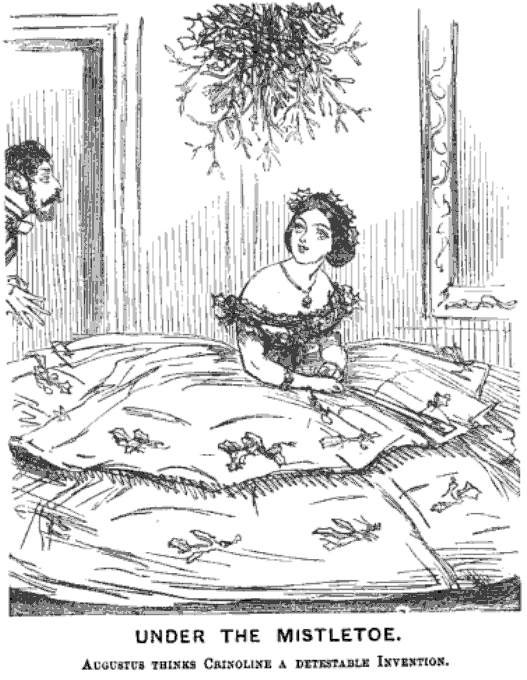
![]() There is a legend both Roman and also Norse that
is essentially the same though with different characters:
There is a legend both Roman and also Norse that
is essentially the same though with different characters:
Both stories involve a goddess and her son, for the Romans they are Venus, the goddess of love and Apollo, the god of music, poetry, prophecy and medicine. For the Norse, there is Frigga, also the goddess of love and Balda the god of light. The mother goddesses had protected their sons from all harm in the world except for mistletoe and whaddya know? They both had their hearts pierced with sharpened sprigs of mistletoe, by evil spirits or other gods.
When the mothers found out about the death their tears became the white berries of the mistletoe. The story has a happy ending however, as luck would have it the respective sons were brought back to life again (an advantage of being the godly son of a goddess I guess) and the mothers Venus and Frigga were so happy that they kissed anyone who walked under the mistletoe.
![]() Mistletoe kissing etiquette dictates that a man should pluck
a berry when he kisses a woman under a branch of the plant,
when the last berry is gone, there should be no more kissing!
Girls who refuse to be kissed under the mistletoe will remain
spinsters and become "old maids".
Mistletoe kissing etiquette dictates that a man should pluck
a berry when he kisses a woman under a branch of the plant,
when the last berry is gone, there should be no more kissing!
Girls who refuse to be kissed under the mistletoe will remain
spinsters and become "old maids".
![]() Mistletoe was believed to have the power of fertility.
In some parts of England the Christmas mistletoe was burned
on twelfth night. If it wasn't then the boys and girls who kissed
under it may never marry.
Mistletoe was believed to have the power of fertility.
In some parts of England the Christmas mistletoe was burned
on twelfth night. If it wasn't then the boys and girls who kissed
under it may never marry.
![]() In Scandinavia, mistletoe was considered a plant of peace and
harmony. Enemies could declare a truce or warring spouses
kiss and make-up under a branch of mistletoe.
In Scandinavia, mistletoe was considered a plant of peace and
harmony. Enemies could declare a truce or warring spouses
kiss and make-up under a branch of mistletoe.
![]() The early Christian church banned the use of mistletoe in Christmas
celebrations because of its pagan origins. Church fathers
suggested the use of holly as an appropriate substitute for
Christmas greenery. As was the case with holly, simply having
the taint of paganism wasn't going to let people ignore such
an excellent winter decoration as mistletoe. This must have
been especially true given that it provided excuses to kiss
members of the opposite sex at parties, so the Christianization
of mistletoe began and convenient legends were made up - err
sorry - rediscovered. One legend was that mistletoe used to
be a tree, the wood of which was used to make Christ's crucifixion
cross. As punishment for its role in the death of Christ, mistletoe
was cursed and not welcome on the earth having to return dependent
on other trees for its life.
The early Christian church banned the use of mistletoe in Christmas
celebrations because of its pagan origins. Church fathers
suggested the use of holly as an appropriate substitute for
Christmas greenery. As was the case with holly, simply having
the taint of paganism wasn't going to let people ignore such
an excellent winter decoration as mistletoe. This must have
been especially true given that it provided excuses to kiss
members of the opposite sex at parties, so the Christianization
of mistletoe began and convenient legends were made up - err
sorry - rediscovered. One legend was that mistletoe used to
be a tree, the wood of which was used to make Christ's crucifixion
cross. As punishment for its role in the death of Christ, mistletoe
was cursed and not welcome on the earth having to return dependent
on other trees for its life.
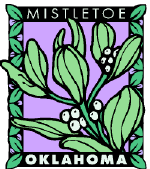
![]() North American mistletoe
North American mistletoe
To the early pioneers who saw the mistletoe growing thick and luxuriantly in the trees in the bleak winter months, it became an inspiration signifying survival, hardiness and endurance. During the winter, as in Northern Europe, it was often the only greenery available to put on graves or to use at weddings. As pioneers, they ignored the pagan history and associations of mistletoe.
It became the official flower of Oklahoma Territory (and later the State of Oklahoma) in 1893, initially against the wishes of some churches due to the pagan associations. In the language of flowers, mistletoe means "I surmount all difficulties", very appropriate for the pioneers.
Christmas Trees
O Tannenbaum, O Tannenbaum,
Wie treu sind deine Blatter.
Du gronst nicht
nur zur Sommerzeit,
Nein, auch im Winter, wenn es
schneit.
O Tannenbaum, O Tannenbaum,
Wie treu sind deine Blatter.
O Christmas Tree, O Christmas Tree,
Your
branches green delight us.
They're green when summer
days are bright:
They're green when winter snow is
white.
O Christmas Tree, O Christmas Tree,
Your
branches green delight us.
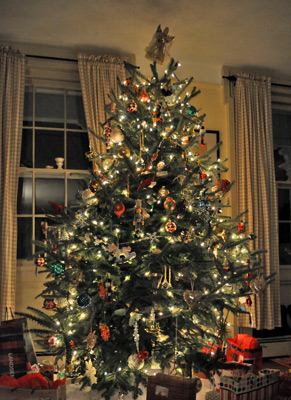
![]() Unlike many other trees in folk-lore, pines, firs and cedars
succumb to the trait of all looking very similar and having
the overwhelming similar trait of remaining green all through
the year. So there tend not to be separate beliefs
surrounding the Scots Pine, Swamp Cypress, Caucasian Pine and
so on, but lore about evergreen trees with needles instead of
broad leaves in general whether they are from Egypt, Greece,
Scandinavia or Siberia.
Unlike many other trees in folk-lore, pines, firs and cedars
succumb to the trait of all looking very similar and having
the overwhelming similar trait of remaining green all through
the year. So there tend not to be separate beliefs
surrounding the Scots Pine, Swamp Cypress, Caucasian Pine and
so on, but lore about evergreen trees with needles instead of
broad leaves in general whether they are from Egypt, Greece,
Scandinavia or Siberia.
![]() Winter in northern countries is harsh and as the year progresses,
most of the trees, the deciduous ones lost their leaves and
"died" for the season, only a few kinds of tree were
still "alive". So evergreen trees came to symbolize immortality.
They were thought to contain good spirits and possess magical
powers that had resisted the evil spirits that had overcome
and "killed" the deciduous trees. Where the evergreen was, the
evil spirits could not go and so evergreen branches were brought
indoors into peoples houses.
Winter in northern countries is harsh and as the year progresses,
most of the trees, the deciduous ones lost their leaves and
"died" for the season, only a few kinds of tree were
still "alive". So evergreen trees came to symbolize immortality.
They were thought to contain good spirits and possess magical
powers that had resisted the evil spirits that had overcome
and "killed" the deciduous trees. Where the evergreen was, the
evil spirits could not go and so evergreen branches were brought
indoors into peoples houses.
Over time, the original intentions of bringing such greenery into houses was forgotten and the evergreen became simply decorative. Branches were made into ropes or garlands and draped over mantelpieces, mirrors, pictures and along the ceiling.
![]() Decorating whole trees was initially a pagan tradition from
the Upper Rhine region of Germany, trees were also
sometimes placed in village squares. As ever the church did
not want to be seen to be ignored in such matters, nor did it
wish that people still practiced old pagan rituals and festivities,
so by around the 15th and into the 16th centuries, the idea
of decorating trees with apples arose to symbolize Adam and
Eve's expulsion from Eden. Such trees were known as "Paradise
Trees" and were erected in time for December the 24th, the feast
day of Adam and Eve. At a time when many people could not read
or did not have access to books, the tree became the centre
of a "Paradise Play" used to teach the creation of man and the
fall from grace of Adam and Eve in the garden of Eden
Decorating whole trees was initially a pagan tradition from
the Upper Rhine region of Germany, trees were also
sometimes placed in village squares. As ever the church did
not want to be seen to be ignored in such matters, nor did it
wish that people still practiced old pagan rituals and festivities,
so by around the 15th and into the 16th centuries, the idea
of decorating trees with apples arose to symbolize Adam and
Eve's expulsion from Eden. Such trees were known as "Paradise
Trees" and were erected in time for December the 24th, the feast
day of Adam and Eve. At a time when many people could not read
or did not have access to books, the tree became the centre
of a "Paradise Play" used to teach the creation of man and the
fall from grace of Adam and Eve in the garden of Eden
![]() The first record of a decorated tree at Christmas is from Germany,
Strasburg in 1605 when there is a description of fir
trees festooned with "paper, apples, gold-foil and sweets".
The star atop the tree was added to recall the star on the first
Christmas night. Decorations were mainly made of food items,
wafers, sweets and fruits. Later on small gifts were hung on
the trees too.
The first record of a decorated tree at Christmas is from Germany,
Strasburg in 1605 when there is a description of fir
trees festooned with "paper, apples, gold-foil and sweets".
The star atop the tree was added to recall the star on the first
Christmas night. Decorations were mainly made of food items,
wafers, sweets and fruits. Later on small gifts were hung on
the trees too.
![]() Candles were then added to the decorations as symbols of the
returning sun and because in Christian tradition, they represent
Christ as the Light of the World. This idea is said
to derive from Martin Luther, while walking home one star-lit
winter's night he was awe struck by the brilliant stars in the
dark night sky as a backdrop to evergreen trees To teach others
that Christ was "light of the world" he placed candles on an
evergreen tree to emulate the scene he witnessed.
Candles were then added to the decorations as symbols of the
returning sun and because in Christian tradition, they represent
Christ as the Light of the World. This idea is said
to derive from Martin Luther, while walking home one star-lit
winter's night he was awe struck by the brilliant stars in the
dark night sky as a backdrop to evergreen trees To teach others
that Christ was "light of the world" he placed candles on an
evergreen tree to emulate the scene he witnessed.

![]() Christmas trees were brought to England in the early 1800's
but it was Prince Albert the consort of Queen Victoria who popularised
the practice in Britain later in the century by erecting
a large Christmas Tree in Windsor Castle in 1841 as it was the
tradition in his native Germany.
Christmas trees were brought to England in the early 1800's
but it was Prince Albert the consort of Queen Victoria who popularised
the practice in Britain later in the century by erecting
a large Christmas Tree in Windsor Castle in 1841 as it was the
tradition in his native Germany.
![]() There are many legends about Christmas trees that are quite
clearly thought up after the event to explain the way things
are. One such story about a woodcutter for instance
has the man helping a poor hungry child in the forest on Christmas
Eve (in other versions the child knocks at the woodcutters door).
The next day (Christmas Day) the child reappears to the man
and his wife and reveals that he is in fact the Christ Child,
he breaks a branch from a fir tree and gives it to the couple
(or plants a small fir tree next to the door). He tells them
to plant and look after it and at Christmas it will bear fruit,
sure enough as promised the tree becomes covered with fruit
- in some versions there are apples of gold and nuts of silver.
There are many legends about Christmas trees that are quite
clearly thought up after the event to explain the way things
are. One such story about a woodcutter for instance
has the man helping a poor hungry child in the forest on Christmas
Eve (in other versions the child knocks at the woodcutters door).
The next day (Christmas Day) the child reappears to the man
and his wife and reveals that he is in fact the Christ Child,
he breaks a branch from a fir tree and gives it to the couple
(or plants a small fir tree next to the door). He tells them
to plant and look after it and at Christmas it will bear fruit,
sure enough as promised the tree becomes covered with fruit
- in some versions there are apples of gold and nuts of silver.
![]() Another legend tells of Saint Boniface an English monk a missionary
who organized the early Christian Church in France and Germany.
He came about a group of people gathered around an oak tree
in 725 A.D. (sometimes said to be the sacred Donar Oak near
Geismar) about to sacrifice a child (in other versions he takes
them out specifically to find an oak in the forest). To save
the child's life or to show that the oak is just a tree and
not sacred (depending on the version) he fells the tree with
an axe (or even just a single mighty blow of his fist!). As
it falls, the mighty oak fells all the other trees in it's path
except for a single small fir tree (or in its place grows a
single fir tree) Boniface tells the pagans that the evergreen
fir is the Tree of Life and represents the eternal life of Christ.
Another legend tells of Saint Boniface an English monk a missionary
who organized the early Christian Church in France and Germany.
He came about a group of people gathered around an oak tree
in 725 A.D. (sometimes said to be the sacred Donar Oak near
Geismar) about to sacrifice a child (in other versions he takes
them out specifically to find an oak in the forest). To save
the child's life or to show that the oak is just a tree and
not sacred (depending on the version) he fells the tree with
an axe (or even just a single mighty blow of his fist!). As
it falls, the mighty oak fells all the other trees in it's path
except for a single small fir tree (or in its place grows a
single fir tree) Boniface tells the pagans that the evergreen
fir is the Tree of Life and represents the eternal life of Christ.
![]() Initially Christmas trees were rather a luxury item only for
the well-to-do, but as time went on and people became
more affluent and goods cheaper, Christmas trees came into the
reach of all. They soon caught on and today, we can't imagine
a house decorated for Christmas without a tree as the centre
of it all.
Initially Christmas trees were rather a luxury item only for
the well-to-do, but as time went on and people became
more affluent and goods cheaper, Christmas trees came into the
reach of all. They soon caught on and today, we can't imagine
a house decorated for Christmas without a tree as the centre
of it all.
Care for your Christmas tree
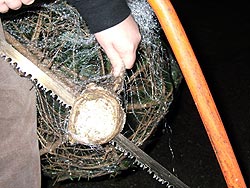 Ideally
the tree should be placed in a cool place, not easy
with modern houses. At least put it a distance from heat sources
such as radiators or fires where possible.
Ideally
the tree should be placed in a cool place, not easy
with modern houses. At least put it a distance from heat sources
such as radiators or fires where possible.
When you first get the tree home, take off a thin slice of the trunk from the bottom using a sharp saw. This will level it off and also remove any callusing or detritus that has found its way into the fine tubes of the wood and may block the flow of water up the trunk. If you can (excitable children permitting) then put the end of the tree into a bucket of water for up to a day to let the tree have a long deep drink, it will almost certainly be very dried out when you get it even if it doesn't look it.
Water the tree regularly. Either place it in a specially made holder with a water reservoir or support it in a water-proof container filled with sand or gravel. Water it as you would flowers in a vase on a regular basis. This will keep it moist, fresh and less likely to shed it's needles - no it won't work completely - but it will help.
Make sure you unplug the fairy lights first! There is a small but significant number of people who are killed each year (yes killed!) by watering their Christmas trees with the lights plugged in and with an over-abundance of water in the wrong places.
The Yule Log

![]() Great fires of evergreen logs were burned by druids in the winter
solstice to draw back the sun and is thought to have become
the custom of burning the Yule Log.
Great fires of evergreen logs were burned by druids in the winter
solstice to draw back the sun and is thought to have become
the custom of burning the Yule Log.
![]() The burning of the Yule Log was at one time one of the most
firmly adhered to of the Christmas customs. First of
all a Yule log had to be obtained either from one's own land
or from a neighbours wood, buying one was unlucky. It should
be a substantial piece of wood, sometimes a tree stump or root
would do the job just as well and that was brought home on Christmas
Eve and laid on the fire hearth.
The burning of the Yule Log was at one time one of the most
firmly adhered to of the Christmas customs. First of
all a Yule log had to be obtained either from one's own land
or from a neighbours wood, buying one was unlucky. It should
be a substantial piece of wood, sometimes a tree stump or root
would do the job just as well and that was brought home on Christmas
Eve and laid on the fire hearth.
The log should be lit using a left over and carefully saved piece of last year's Yule log. It would have spent the intervening year under the owners bed where it performed stalwart service in keeping the house safe from fires and lightning. Clean hands were required to handle the new and old logs so as not be disrespectful and if the log didn't light first time it was a sure sign of impending misfortune for the family.
Once alight, the log had to be kept burning for at least 12 hours, it could not be tended at all during the long Christmas Eve supper as long as a scrap of food remained on the table or if anyone was still eating. As it burned so Christmas ghost stories and tales of olden times were told washed down with the customary cider or perry (a cider-like drink made from pears rather than apples).
![]() In scientific terms, the Yule log is the perfect symbol of stored
life and the returning sun. The log exists because
of an extraordinary sequence of events whereby the light energy
of the sun has been captured during the process of photosynthesis
that powers all plants. A series of physical and chemical reactions
has led to chemical bonds storing light energy, when these bonds
are "snapped" by burning, out comes the stored energy as light
and heat.
In scientific terms, the Yule log is the perfect symbol of stored
life and the returning sun. The log exists because
of an extraordinary sequence of events whereby the light energy
of the sun has been captured during the process of photosynthesis
that powers all plants. A series of physical and chemical reactions
has led to chemical bonds storing light energy, when these bonds
are "snapped" by burning, out comes the stored energy as light
and heat.
Picture credits: Robin - Francis C. Franklin used under CC3 Share Alike licence / Holly with frost - Erich Ferdinand used under CC2 Attribution Generic license / Holly in snow - Randi Hausken, Baerum Norway used under CC2 Attribution Share and Share Alike Generic license / Mistletoe with berries - Schnobby used under CC3 Attribution Share and Share Alike Unported license / Mistletoe in tree - H. Krisp CC3 Attribution Unported license
Copyright 2000 - present. All Rights Reserved | Privacy Policy Statement
